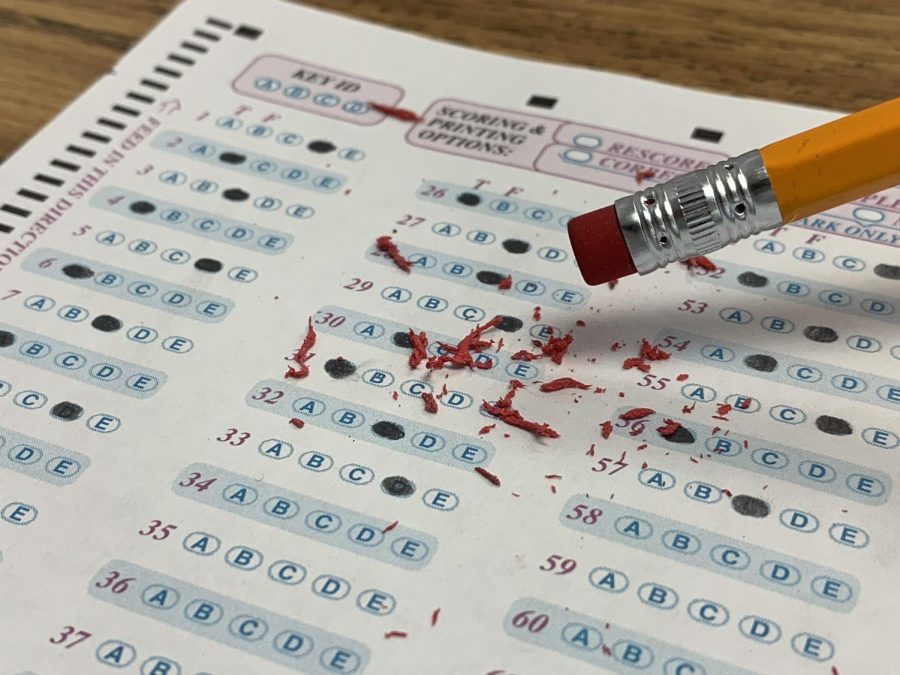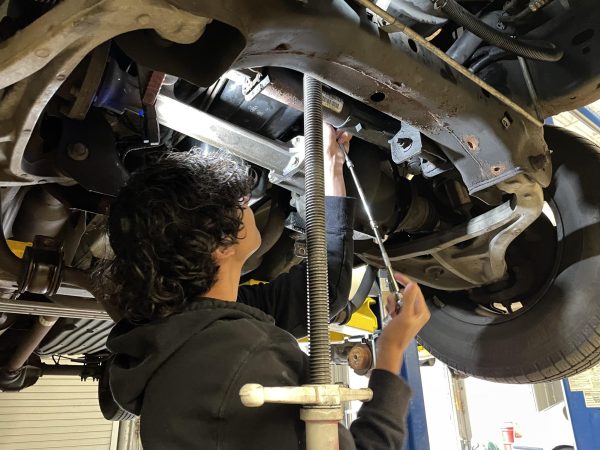OVER TESTING
State reduces number of required SOLs while colleges reconsider role of SAT
As he prepares to wrap-up his high school career, senior Abbey Yared looks forward to the summer and spending the next four years at the University of Virginia. However, he finds his path blocked by an all too familiar object, standardized testing.
Throughout high school, Yared has grown accustomed to the standardized testing environment. Whether it has been Standards of Learning (SOL) testing, the SAT, ACT or the upcoming IB Exams, he has learned and adapted to the nature of such exams.
Nonetheless, after dealing with the test-taking process for a decade, it begs the question: “Was it worth it?”
Although Yared feels that he was over tested throughout high school, changes are on the way.
With the state reducing the number of required SOLs and colleges beginning to place less emphasis on the SAT, actions have been taken to combat over testing. The purpose of standardized tests, particularly the SOL is to assess if students are meeting requirements set by the state for various subjects including mathematics, English, science and social studies.
This past year, the state changed and the wording and requirements regarding the SOLs. With the new changes, students are now prohibited from taking an SOL if they have met their SOL requirements for graduation.
Before this change was implemented, students were expected to take the SOL if they were in a course that was associated with the test. Now, students will only take the SOL if they have not met the SOL graduation requirement for that subject area or for their student selected SOL.
Additionally, the requirements for students who entered the ninth grade in 2018-19 school year have different requirements than before. For the standard diploma, students need to earn a total five verified credits, a decrease from the previous requirement of six verified credits.
Requirements for the Advanced Studies diploma drastically changed on the verified credits end as well as the number of verified credits has been lowered from nine to five.
“The SOL is not becoming less emphasized,” Director of Student Services Jennifer Crump-Strawderman said. “The SOL pass rates are one of many requirements for our state accreditation, so they can’t be less emphasized.”
With less testing requirements, students are being relieved of having to prepare for as many examinations.
“I think the change is that the state does not want to unnecessarily test students,” Crump-Strawderman said. “So they have made adjustments to when students should test but the tests and results are still as important as they were in previous years.”
Students do not agree with the notion that this kind of testing the most efficient way of evaluating their progress year by year.
“I honestly think that the amount of time we as students put in during class and at home should be valued more
than a few hours of exams at the end of each year,” Yared said. “I understand that we’re tested to see if we’re meeting standards, but there are more effective ways judge that.”
With many students finding their interests in one or two subjects, it appears to be excessive to overly test students in subjects that they will not have future interest in, whether it be in college or as a potential career path.
“For me, I find most of my interest in history and engineering,” Yared said. “It’s still important to learn and gain knowledge in other subjects and classes, but I don’t think everything needs to be focused on equally.”
Evidently, standardized testing is not only limited to the SOL as students still face many other forms of examination. Every school year, high school students spend endless hours stressing over one three-letter test that can define their collegiate futures: the SAT.
Originally introduced in 1926, the SAT has been a major factor in determining student acceptance into universities and colleges after high school. Not only are student scores used as part of the decision to accept an applicant to a college, but they are also used in awarding merit-based scholarships.
With this being the case, a countless amount of students spend time studying and preparing for the exam, particularly during their junior and senior years of high school.
Student study methods typically include using online practice tests released or made available by the College Board (the organization that administers the SAT), using practice books and study guides, or even preparing for the exam with a tutor.
“When I was getting ready to take the SAT, I used multiple forms of preparation,” senior Reade Sherif said. “The practice tests online were probably the most helpful thing and my tutor helped me work through tutor helped me work through questions as well.”
Students find themselves using guided practice questions online and also learning tips on taking the SAT from these same sources such as Khan Academy.
“Khan Academy was a pretty useful for test preparation because it explains how to solve and also provides a faster way of completing the questions,” senior Alex Brennan said.
Despite the historical importance of the SAT in the college application process, many schools are making changes to the value the test has in determining if a student should be accepted or not.
As of September, there have been more than 1,000 accredited, bachelor degree granting institutions that have become test-optional. If a school is test-optional, that means that the decision to send SAT scores to the school for consideration with a college application is left completely up to the applicant.
There are a number of highly ranked test optional schools including: the University of Chicago, George Washington University, the University of Iowa, Wake Forest University, etc.
In addition, Score Choice, program implemented by the College Board, allows students who have taken the SAT multiple times to select and submit their only best scores to colleges.
With score choice, students can select their best score from the evidence-based reading and writing section and their best score from the mathematics section.
“I think the SAT as a requirement does not help in evaluating a student,” senior Izzy Yahia said. “A different form of standardized testing such as subject tests where students study for and take the subject test that they are most likely to major in would be a good replacement.”
Another form of standardized testing which is mostly relevant to high school seniors and juniors are IB
Exams. In order to earn an IB credit for a respective IB course, students must not only pass the course, but also earn a certain score on the exam.
These tests are much more rigorous as they are based on international standards and are associated with higher level courses. Despite the rigor, there are multiple benefits to not only the courses but the exams as well.
“Some of the topics that appear in the exams will be pretty relevant for students who take higher level math courses in college,” IB Math teacher Evaristo Martins said.
“Taking the exams is beneficial because colleges do like to see students taking IB and AP exams.”
In addition to becoming familiar with material they will see again in college, students also have the opportunity to earn college credits by taking IB exams.
With the many forms of standardized testing, it is a mixed bag as far as benefits and drawbacks. Although the significance of valid arguments against over testing and the stress associated with studying, many forms of standardized testing in general will remain intact for the foreseeable future.

Senior Jude Nanaw is the current Co-Editor in Chief of The A-Blast. He has been on staff for four years where in previous years he has held the positions...














